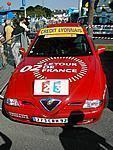
 |
 |
 |
 |
 |
 |
89th Tour de France - Grand Tour
France, July 6-28, 2002
When the Back Seat is the Front Row
by Chris Henry
 |
If there's one way to ride the Tour de France in style, it's in car number one of the Tour's Direction Generale. Tour boss Jean-Marie Leblanc follows each stage in a fully-equipped six-speed Alfa Romeo 3 litre sedan, driven by Robert Lelangue. Before yesterday's time trial, Lelangue gave Cyclingnews' Chris Henry a look inside at the seat of power.
Leblanc rides in the back left seat, while each day's invited guest sits on the right. Between the two is a small refrigerator and a multi-channel radio console for internal Tour communications. As part of the car's customized rear seats, the radio and fridge also help keep the invited guests safely in their seats during the hairpin descents once the Tour reaches the mountains.
The car is equipped with a global positioning system (GPS), has a custom sunroof that permits Leblanc to stand and overlook the race from the back seat, and of course has all the comforts one would expect in the race's most important car. Inside are copies of each day's stage map and profile, as well as the list of each rider and his race number.
 |
Four principal radio channels are in use each day during the race. First is Radio Tour, which provides the organization, team, and press vehicles with constant updates on the race progress. In addition, Radio Tour announces any crashes or mechanical incidents and provides a heads-up for team cars when riders are in need of an equipment change, water bottles, etc. A second channel is the information channel, providing updates from the race direction motorcycles which ride ahead of the race.
A separate internal channel is also available only within the Direction, for communication between Leblanc, Jean-Fran¨ois Pescheux, Daniel Baal, and Patrice Clerc, the President of the Direction. Yet another channel is dedicated to communications from the race commissaires, although this channel is primarily used by Pescheux, the Director of Competition, who rides in a separate car. An intercept is also available to the national police for any security or safety issues which may arise during the race.
The radio system begins as an internal communication link between the members of the direction, but once the race passes the official start at kilometer zero, the signal is sent to an airplane which provides a relay of up to 200km for the caravans within and ahead of the race.
Interestingly enough, all of the direction cars are equipped with televisions- except Leblanc's. As Lelangue explained, his car is in the center of the action at all times, and thus a television becomes unnecessary distraction. For the organization, as well as the riders, distractions are seldom welcome on the route du Tour.

